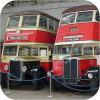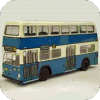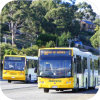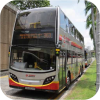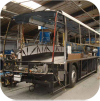AUSTRALIA SHOWBUS BUS IMAGE GALLERY
Sydney Bus Museum | Sydney singledeckers
 |
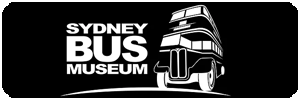 |
||||
Page 4 |
|||||
|
Preserved in the special livery for the first official Australian visit of Her Majesty Queen Elizabeth II is 1954 Commonwealth Engineering bodied AEC Regal IV 2807. Behind, awaiting restoration in 2003 was Adelaide Daimler CVG6 112. A start on its restoration commenced in 2018.
|
|
A better view of 2807 in the new Museum's Leichhardt home in November 2016.
Picture ref B5018 |
|
Wartime purchases were problematic. Whilst Sydney lost few buses by enemy action, unlike London and other UK cities, it struggled to keep its fleet on the road with spares from the UK virtually unobtainable. To alleviate the problem it managed to obtain 53 Ford FCB 194 utility chassis and had them bodied with these austere bodies by Properts. As new bus chassis arrived from the UK after the War the Fords were disposed of in 1948, though some saw further state service as trailers with the tram and rail divisions. This one, 1756, passed to Fairbridge Farm School in Molong, NSW and ended up as a shed in Molong in 1964. It was rescued for preservation in 1990.
Picture ref B5015 |
|
This White 50B unit was undergoing major restoration at Leichhardt in November 2016. New in 1926 with a Smith & Waddington body for the Metropolitan Omnibus Transport Company (MOTC) the bus was sold to the New South Wales state in March 1933 when legislation prohobited private companies running bus services in competition with the State's trams, trains and ferries. On Christmas Day in 1932, the state started its own first bus service from Cremorne Junction to Manly Wharf, the 144. This White, numbered 1030, operated on the 144 for six years until auctioned off to Lowes Bus Service of Alexandria in 1939. In 1947 it was sold off to become a motor home being rescued for preservation in 1970, joinimg the Museum's collection in 2005. Apparently the intention is not to restore the bus to a fully operational condition as it would be too frail to be operate on today's roads.
Picture ref B5027 |
|
Another White, with a similar history to 1030. The 54A model from 1930 being more larger and more powerful, required state regulations to be relaxed to enable its operation. The low slung chassis was one of the first in the country fitted with air brakes and the body by Walsh Island Dockyard in Newcastle was the first all metal body built in Australia. It entered service on route 42 between Campsie and the city for Deluxe Bus Service, shortly after being joined by three similar motors. Their use was short lived, falling foul of the new legislation in 1931. Stored until 1937 the four operated for the state from Fitzgibbon depot, this White becoming number 1500. Two years later it was sold to Rover of Cessnock. It later passed to Quodling Brothers in Queanbeyan who recognised the significance of the bus and donated it to the Museum’s collection in the sixties.
Picture ref B5021 |
 |
 |
||||
Page 4 |
|||||



